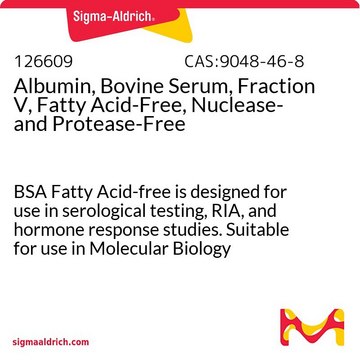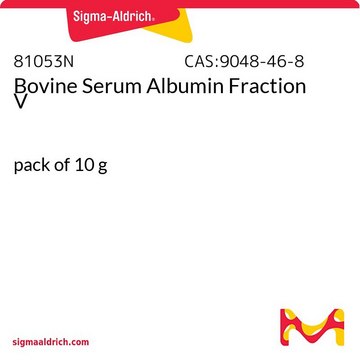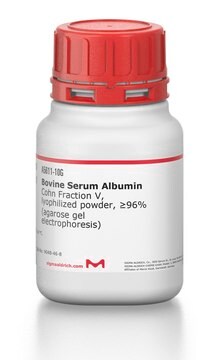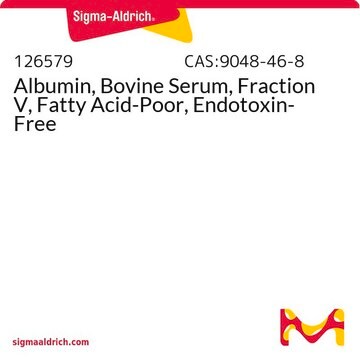03117332001
Roche
Bovine Serum Albumin Fraction V, protease-free
from bovine serum
Sign Into View Organizational & Contract Pricing
All Photos(1)
About This Item
UNSPSC Code:
12352202
NACRES:
NA.21
Recommended Products
biological source
bovine
Quality Level
Assay
≥98.5% albumin basis (electrophoresis)
form
lyophilized
packaging
pkg of 50 g
manufacturer/tradename
Roche
technique(s)
ELISA: suitable
shipped in
wet ice
storage temp.
2-8°C
General description
Bovine serum albumin (BSA) is a globular, α-helical, non-glycosylated protein is produced in the liver. It consists of three homologous, structurally different domains and two sub-domains each. BSA has 17 cysteine residues cross-linked and bound into a single chain.
Application
Bovine Serum Albumin Fraction V, protease-free is used:
- for stabilization of purified enzymes
- for site-blocking reagent in ELISA techniques
- as a protein standard for determination of protein concentration
Biochem/physiol Actions
Bovine Serum Albumin (BSA) facilitates the transmission of drugs, hormones, and fatty acids. It is the most commonly used blocking agent in enzyme-linked immunosorbent assay (ELISA). BSA enhances the differentiation of human embryonic stem cells (hESC) and is also a chief component of cell culture media.
Quality
Contaminants: ≤0.001% heavy metals; proteases not detectable (casein digest)
Other Notes
For life science research only. Not for use in diagnostic procedures.
Storage Class Code
11 - Combustible Solids
WGK
WGK 1
Flash Point(F)
Not applicable
Flash Point(C)
Not applicable
Certificates of Analysis (COA)
Search for Certificates of Analysis (COA) by entering the products Lot/Batch Number. Lot and Batch Numbers can be found on a product’s label following the words ‘Lot’ or ‘Batch’.
Already Own This Product?
Find documentation for the products that you have recently purchased in the Document Library.
Customers Also Viewed
Drew C Tilley et al.
The Journal of general physiology, 151(3), 292-315 (2018-11-07)
Allosteric ligands modulate protein activity by altering the energy landscape of conformational space in ligand-protein complexes. Here we investigate how ligand binding to a K+ channel's voltage sensor allosterically modulates opening of its K+-conductive pore. The tarantula venom peptide guangxitoxin-1E
Amanda B Hummon et al.
BioTechniques, 42(4), 467-470 (2007-05-11)
A systems approach is being applied in many areas of the biological sciences, particularly in cancer research. The coordinated, simultaneous extraction of DNA, RNA, and proteins from a single sample is crucial for accurate correlations between genomic aberrations and their
Glennys V Reynoso et al.
Methods in molecular biology (Clifton, N.J.), 2023, 287-299 (2019-06-27)
This chapter provides methods for the propagation, purification, and titration of vaccinia virus (VACV) and the highly attenuated strain-modified vaccinia Ankara (MVA). Additionally, we provide information on VACV recombinants we have used for intravital imaging with multiphoton excitation.
Tamara Topală et al.
Clujul medical (1957), 87(4), 215-219 (2014-01-01)
The continuous search for new molecules with therapeutic abilities has led to the synthesis and characterization of a large number of metal complexes, proven to exhibit potential as pharmacological agents through their antibacterial, antiviral, antifungal and antineoplastic properties. As serum
Anna Lidia Wojdała et al.
Journal of Alzheimer's disease : JAD, 88(4), 1459-1468 (2022-07-06)
Phosphatidylethanolamine binding protein 1 (PEBP1) is a multifunctional protein, mainly known for its specific binding of phosphatidylethanolamine and the ability to suppress the Raf1-MAPK pathway. Its potential role as an Alzheimer's disease (AD) biomarker has been proposed in several studies.
Our team of scientists has experience in all areas of research including Life Science, Material Science, Chemical Synthesis, Chromatography, Analytical and many others.
Contact Technical Service









